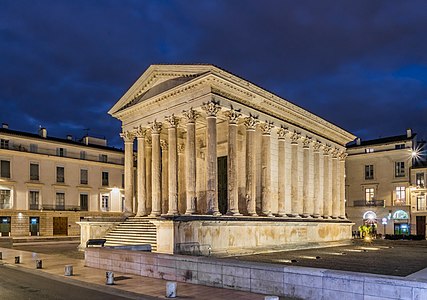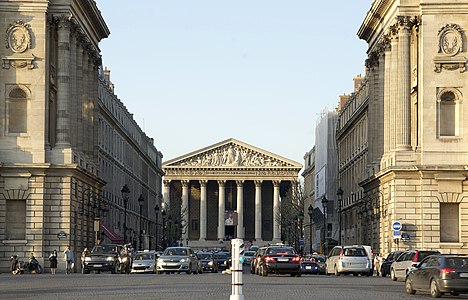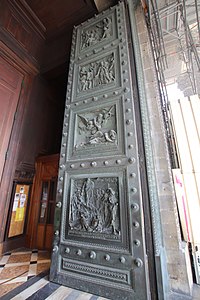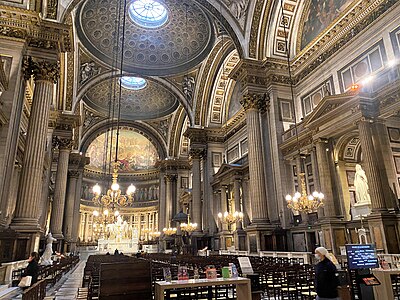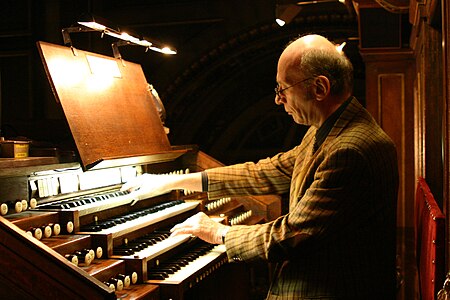La Madeleine, Paris
| Church of Saint-Marie-Madeleine | |
|---|---|
Neo-Classical | |
| Groundbreaking | 1807 |
| Completed | 1828 |
| Specifications | |
| Length | 108 m (354 ft) |
| Width | 43 m (141 ft) |
| Other dimensions | Columns: 20.0 m (65 ft 7 in) |
| Administration | |
| Archdiocese | Paris |
| Laity | |
| Organist(s) | François-Henri Houbart |
Paris, Banks of the Seine | |
|---|---|
| Criteria | Cultural: i, ii, iv |
| Reference | 600 |
| Inscription | 1991 (15th Session) |
The Church of Sainte-Marie-Madeleine (
The exterior and interior of the church are undergoing a major project of cleaning and restoration, which began in 2020 and is scheduled for completion in 2023.[6][7]
History
First church
The neighbourhood, then at the edge of Paris, was annexed to the city in 1722. An earlier church of Saint-Marie-Madeleine was built in the 13th century on avenue Malesherbes, but was considered too small for the growing neighbourhood. Louis XV authorised the construction of a new, larger church, with a view along Rue Royale toward the new Place Louis XV, now Place de la Concorde. In 1763 the King laid the first stone for a new church, designed by Pierre Contant d'Ivry and Guillaume-Martin Couture.[8][9][10]
The first design for the new church by
Proposed monument to Napoleon's Army and railroad station, then church again
The construction of the new church was abruptly halted in 1789 by the
Under the Revolutionary government, a debate began on the future purpose of the building. Proposals included a library, a public ballroom, and a marketplace. The new building of the National Assembly, in the Palais Bourbon, at the other end of the former Rue Royale, was given a classical colonnade to match the already completed portico of church.[11] The new Emperor,
Completion of the church (1855)

After the fall of Napoleon in 1814, the new King,
The architect Vignon died in 1828 before completing the project and was replaced by Jacques-Marie Huvé. A new competition was set up in 1828–29 to determine the design for sculptures for the pediment. The design chosen was "The Last Judgment" , depicting Saint Mary Magdalene kneeling to pray for sinners, by Philippe Joseph Henri Lemaire. The new government of the July Monarchy decided to go ahead with the church, despite financial difficulties. in 1830 they declared that it would be dedicated to national reconciliation. The vaults were finally completed in 1831.[16]
Work on the church was largely completed during the reign of
The new church became popular with musicians. The funeral of
During the
Besides Chopin, musicians and artists whose funerals were held at the church include
Exterior
Inspiration
-
The Temple of Olympian Zeus in Athens (6th century BC)
-
TheMaison Carrée from Nîmes(2 A.D.)
-
Vignon's design for the facade
The design of the church by Vignon was an example of the
South facade and Fronton
-
The view of the church along Rue Royale from the Place de la Concorde. The strict harmony of the buildings was assured by a royal decree in 1824.
-
Detail of the pediment sculpture "The Last Judgement" by Philippe Joseph Henri Lemaire His sculpture is also prominent on the Arc de Triomphe.
The inscription on the frieze over the entrance reads in Latin: D⸱O⸱M⸱SVB⸱INVOCAT⸱S⸱M⸱MAGDALENAE, that is Deo Optimo Maximo sub invocatione Sanctae Mariae Magdalenae ("To God all-powerful and Very Great, under the invocation of Saint Mary Magdalen.")
The pediment sculpture of the
Bronze Doors
-
Bronze door of the South Portal, by Henri de Triqueti
-
Ten Commandments - "Thou shalt not commit Adultery"
-
Detail of bronze doors
The bronze doors of the south portal have reliefs illustrating the Ten Commandments. They measure 108 by 43 m (354 by 141 ft).
Statues in niches of the Colonnade
-
Saint Genevieve
-
Saint Denis of Paris
-
Saint Luke. The statue lost its head to a German shell in World War I.
-
Saint Bernard of Clairvaux
Another feature of the exterior is a series of statues of Saints, made by different sculptors, alternating women and men, arranged on the outside walls along the portico, within the colonnade. The original plan by Vignon had only bare walls on the exterior, but the new architect, Huvé, proposed a series of thirty-three statues in niches. The selection of Saints was largely made by the Orleans family of King
Parts
-
The nave and the choir, facing north toward the altar
-
The choir decoration, Christmas 2022
The plan of the church was inspired more by the classical Roman architecture, particularly the baths, than by traditional church architecture. Inside, the church designed by Huvé is composed of a single long space, without a transept. It is divided into three wide arched bays, each with a dome, with circular skylights that provide limited illumination. All the walls and arches and the ceiling are covered with decoration, largely composed of colored marble in intricate geometric forms, and frequently gilded.[24]
The choir dome - "The History of Christianity"
-
"History of Christianity" and "Christianity in France"
-
The choir and the altar, with "History of Christianity" above
-
"The History of Christianity" fresco by Jules-Claude Ziegler. (Choir)
The cul-de-four or half-dome over the choir of the church is decorated with a painting by Jules-Claude Ziegler (1804-1856) which depicts major events in the history of Christianity, with an emphasis on France. At the top is the figure of Christ with
Mosaic of Lameire - "Christianity of France" and "The Ecstasy of Mary Magdalene"
-
"The Ecstasy of Mary Magdalene" by Carlo Marochetti
-
Mosaic "Christianity of France"
Below the "History of Christianity" and above the altar is later, unusual work; a wide ceramic mosaic depicting Christ with a group of Saints who had connections with France. This was conceived between 1888 and 1893 by Father LeRebours, the curate of the church, and is in the Neo-Byxantine style, very different from the rest of the art in the choir. It painted by Charles-Joseph Lameire, and transformed into ceramic by the
The Christ of the Resurrection is the central figure in the mosaic, accompanied by the first disciples and missionaries who lived and preached in Gaul, including the patron saint of the church,
Below the mosaic is a row of Corinthian columns which form a theatrical background behind the altar. and a marble stairway leading up to the altar. Behind the altar is a monumental sculpture, "The Ecstasy of Mary Magdalene", by Carlo Marochetti (1805-1868), depicting Mary Magdalene, kneeling in prayer, as she is transported into heaven by three Angels.[27]
Sculpture in the Vestibule - "The Baptism of Christ"
-
"The Baptism of Christ" by François Rude
In the vestibule at the south end of the church, is another monumental sculpture, "The Baptism of Christ" by François Rude (1784-1855). Rude was already famous for a work he made in 1836, "The Departure of the Volunteers of 1795", prominently featured on the Arc de Triomphe.[28]
Decoration
-
The pulpit in the nave
-
Detail of the ceiling vaults
-
Baptismal font
The decoration of the interior was completed in a relatively short period, under King Louis-Philippe, and is noted for its unusual harmony.
The organs
-
The organ and its keyboard (1855)
-
The grand organ in the tribune
-
François-Henri Houbart, the current organist in 2022, at the keyboard in 2011
-
The choir organ, behind the altar
The church has had a long association with music and musicians. The funeral of
Organists
- 1842–1846 Charles-Alexandre Fessy
- 1847–1858 Louis James Alfred Lefébure-Wély
- 1858–1877 Camille Saint-Saëns
- 1877–1896 Théodore Dubois
- 1896–1905 Gabriel Fauré
- 1905–1934 Henri Dallier
- 1935–1962 Édouard Mignan
- 1962–1968 Jeanne Demessieux
- 1969–1979 Odile Pierre
- 1979– François-Henri Houbart (2011)
The foyer
In the basement of the Church (entrance on the Flower Market side) is the Foyer de la Madeleine. Typical of various foyers run by religious and civic groups throughout France, the Madeleine is the home of a restaurant in which, for a yearly subscription fee, one can dine under the vaulted ceilings on a three-course French meal served by volunteers for a nominal price. The walls of the Foyer are often decorated by local artists.[33][34]
See also
- List of works by James Pradier Sculptures in La Madeleine
- List of historic churches in Paris
- List of tourist attractions in Paris
References
- ^ Base Mérimée: Eglise de la Madeleine, Ministère français de la Culture. (in French)
- ^ Dumoulin, "Églises de Paris", (2010), p. 144
- ^ "La Madeleine". aviewoncities.com. Retrieved 23 March 2014.
- ^ "ÉGLISE DE LA MADELEINE". en.parisinfo.com. Retrieved 23 March 2014.
- ^ Dumoulin, "Églises de Paris", (2010), p. 146–147
- ^ [1]. Archived 2022-10-05 at the Wayback Machine Restoration section of the church website (in French)
- ^ [2]. Archived 2021-08-04 at the Wayback Machine History section on the church website (in French)
- ^ Dumoulin, "Églises de Paris" (2010), p. 145
- ^ "La Madeleine - Paris, France". sacred-destinations.com. Retrieved 23 March 2014.
- ^ "Vignon's The Church of La Madeleine". smarthistory.khanacademy.org. Archived from the original on 31 October 2014. Retrieved 23 March 2014.
- ^ Dumoulin, "Églises de Paris" (2010), p. 145
- ^ [3] Archived 2021-08-04 at the Wayback Machine History section on the church website (in French)
- ^ Dumoulin, "Églises de Paris" (2010), p. 145
- ^ Dumoulin, "Églises de Paris" (2010), p. 145
- ^ [4] Insecula history of the Church (n French)
- ^ [5] Insecula history of the Church (n French)
- ^ [6] Archived 2021-08-04 at the Wayback Machine History section on the church website (in French)
- ^ [7] Theater Paris site, concert history at La Madeleine, retrieved October 2, 2022
- ^ [8] Archived 2021-08-04 at the Wayback Machine Description of the church on Church website (in French)
- ^ "MadeleineArticle Free Pass". britannica.com. Retrieved 23 March 2014.
- ^ "EGLISE DE LA MADELEINE". francethisway.com. Retrieved 23 March 2014.
- ^ [9] Archived 2021-08-04 at the Wayback Machine Description of the church on the Parish website (in French)
- ^ [10] Archived 2021-08-04 at the Wayback Machine Description of the church on the Parish website (in French)
- ^ Dumoulin (2010), p. 146
- ^ Dumoulin (2010), p. 146
- ^ [11] Parish website, description of church
- ^ Dumoulin (2010), p. 147
- ^ Dumoulin (2010), p. 147
- ^ Dumoulin (2010), p. 146
- ISBN 9781576470046. Retrieved 23 March 2014.
- ^ "The Cavaille-Coll organ of La Madeleine, Paris". signumrecords.com. Retrieved 23 March 2014.
- ^ "Appendix J Parisian Organists - A Directory of Composers for" (PDF). rscm.u-net.com. Archived from the original (PDF) on 10 March 2013. Retrieved 23 March 2014.
- ^ "ÉGLISE DE LA MADELEINE REVIEW". fodors.com. Retrieved 23 March 2014.
- ^ "Place de la Madeleine". lonelyplanet.com. Retrieved 23 March 2014.
Bibliography (In French)
- Dumoulin, Aline; Ardisson, Alexandra; Maingard, Jérôme; Antonello, Murielle; Églises de Paris (2010), Éditions Massin, Issy-Les-Moulineaux, ISBN 978-2-7072-0683-1
External links
- History of church on its website (in French)
- 3D model of the church for use in Google Earth Archived 2007-01-27 at the Wayback Machine
- Insecula: Église de la Madeleine History of the site and the structure (in French)


